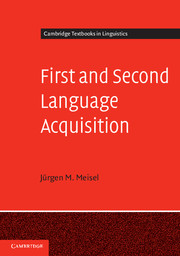Book contents
- Frontmatter
- Contents
- List of figures
- List of tables
- Preface
- List of abbreviations
- 1 The quest for the LAD
- 2 First language development: Universal Grammar as the centrepiece of the human language making capacity
- 3 Obvious (observable) similarities and differences between first and second language acquisition: Developmental sequences
- 4 The initial state and beyond
- 5 Developing grammatical knowledge: Parameter setting and inductive learning
- 6 Neural maturation and age: Opening and closing windows of opportunities
- 7 A (tentative) theory of language acquisition – L1, 2L1 and L2
- Glossary
- Notes
- References
- Index
- References
5 - Developing grammatical knowledge: Parameter setting and inductive learning
Published online by Cambridge University Press: 05 June 2012
- Frontmatter
- Contents
- List of figures
- List of tables
- Preface
- List of abbreviations
- 1 The quest for the LAD
- 2 First language development: Universal Grammar as the centrepiece of the human language making capacity
- 3 Obvious (observable) similarities and differences between first and second language acquisition: Developmental sequences
- 4 The initial state and beyond
- 5 Developing grammatical knowledge: Parameter setting and inductive learning
- 6 Neural maturation and age: Opening and closing windows of opportunities
- 7 A (tentative) theory of language acquisition – L1, 2L1 and L2
- Glossary
- Notes
- References
- Index
- References
Summary
Access to UG principles in L2 acquisition
Our quest for the LAD, the principles and mechanisms of the human mind enabling the child to acquire language, and the exploration of its fate in the course of subsequent developments, has so far revealed a number of substantial parallels as well as pointed differences between first and second language acquisition. As such, this is hardly a surprising result. Rather, this summary of the state of affairs corresponds to what could be expected and to what was actually suspected at the starting point of our discussion in chapter 1. I nevertheless believe that we have made some headway since we are now able to substantiate such expectations in terms of specific characteristics of linguistic development. We saw in chapters 2 and 3 that learners of both acquisition types proceed through invariant sequences in their acquisition of syntactic and morphological properties of the target languages. Yet these sequences are not identical in L1 and in L2 acquisition. Moreover, the two types of acquisition differ substantially even at the initial state and during very early developmental phases, as discussed in chapter 4. These findings result from descriptive generalizations based on a wide array of empirical observations. Whereas some of these refer to phenomena which, although attested in both acquisition types, differ with respect to their order of emergence or in that they appear in different structural contexts, others distinguish L1 and L2 in that they occur in the speech of only one type of learner, for example certain positions of the negative element reported on in section 3.3, differences in the acquisition of bound versus free morphemes (3.2), or the placement of non-finite verbs in verb-second contexts (4.4), all characteristics of L2 speech.
- Type
- Chapter
- Information
- First and Second Language AcquisitionParallels and Differences, pp. 139 - 201Publisher: Cambridge University PressPrint publication year: 2011



